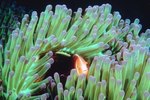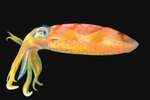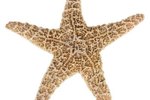
Jellyfish are recognized for their stinging tentacles, anemones for their floral presentation. They're not known for their dietary habits. Both carnivorous members of the phylum Cnidaria, jellies' and anemones' bodily systems allow them to consume and digest food in similar ways, with a few differences.
How Anemones Capture Food
It's easy to consider jellyfish predatory -- many a human has felt their stinging tentacles just feet from dry land -- but anemones are estimable predators, as well. potential prey. The Electronic Atlas of the Fauna of British Columbia characterizes anemones as “silent slow-motion predators.” They use stinging tentacles that surround their central mouth structures to immobilize and collect prey. Extremely small stinging capsules cover anemones’ tentacles and serve as their primary weapons, enabling them to pierce the skin of their prey, hold them in place and inject them with a paralyzing poison.
Sea Anemone Digestion
These friendly looking creatures contain powerful digestive enzymes that are capable of breaking down small animals in approximately 15 minutes. After an anemone captures a meal, it moves the the prey into its mouth and consumes it whole, according to the “Journal of the Marine Biological Association of the United Kingdom.” Within the anemone’s central cavity, food disintegrates into nutrients the creature can absorb. The anemone will later expel shells, bones and any other parts it is unable to digest.
How Jellyfish Capture Food
Jellyfish passively collect plankton and other delicacies floating in the water. Biologists note that jellies can intentionally propel themselves to create currents that force prey within reach, increasing their proverbial harvest. Like anemones, jellyfish tentacles are covered with tiny stinging capsules -- or, nematocysts -- that act like poisonous barbs. According to the South Carolina Department of Natural Resources, jellies have between four to eight oral arms that help move captured food from the tentacles into the mouth. Jellyfish feed on a steady diet of tiny animal plankton and even other jellyfish. Some larger varieties can consume crustaceans and bigger ocean-dwellers.
Jellyfish Digestion
According to the National Ocean Service, jellyfish have rather simplified digestive systems -- often referred to by biologists as incomplete. Many animals rely on organs such as the liver, pancreas and intestines to aid in digestion, the jellyfish has none of these. A single cavity, the coelenteron, serves as a jellyfish’s stomach and intestine. Food that makes it into the jellyfish’s stomach is broken down by digestive enzymes produced by cells lining the inner body cavity. These cells help absorb and direct nutrients around the jellyfish body. Jellies have only one orifice into the digestive cavity, which acts as a mouth, for the intake of sustenance, and as an anus, for the expulsion of waste.
References
- Te Ara - the Encyclopedia of New Zealand: Corals, Anemones and Jellyfish
- Electronic Atlas of the Fauna of British Columbia: Introduction to Sea Anemones
- Waikiki Aquarium: Marine Life Profile: Sea Anemones
- Journal of the Marine Biological Association of the United Kingdom; Digestion in Sea Anemones; J.A.C. Nicol
- Roger Williams University: Jellyfish Feeding and Ecology
- National Science Foundation: Jellyfish Gone Wild
- Oceana: About Jellyfish
- South Carolina Department of Natural Resources: Jellyfish
- National Ocean Service: Only About Five Percent of the Body of a Jellyfish Is Solid Matter; the Rest Is Water
Photo Credits
-
John Foxx/Stockbyte/Getty Images
Writer Bio
Based in Los Angeles, Monica Stevens has been a professional writer since 2005. She covers topics such as health, education, arts and culture, for a variety of local magazines and newspapers. Stevens holds a Bachelor of Arts in journalism, with a concentration in film studies, from Pepperdine University.




